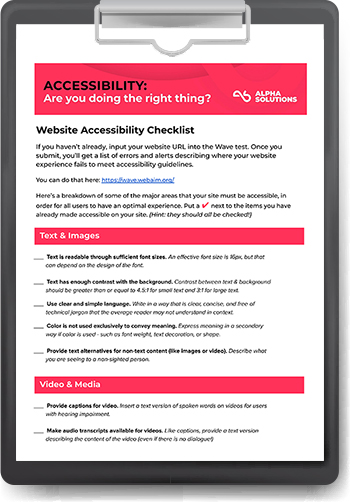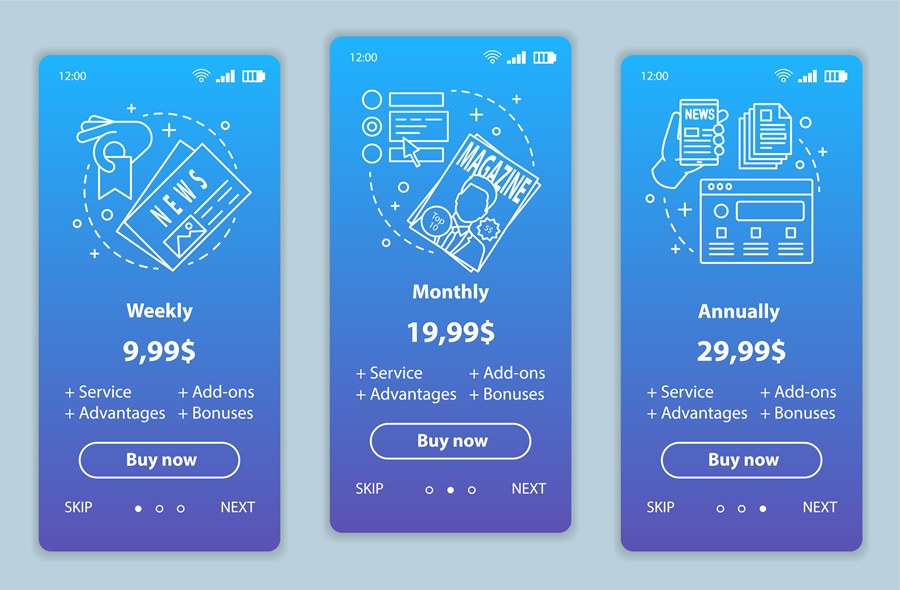Ambitious business owners are constantly looking for new and exciting ways to ensure sustainability and expedite growth. We’re always watching where things are heading so our clients stay ahead of the pack.
One trend we’re staying on top of has been the adoption of subscription models, which now permeate everything from media and software to fitness and food delivery.
You can probably think of many examples of subscription revenue models in your everyday life…
-
Hello Fresh subscribers enjoy weekly meal kits delivered to their door
-
Netflix subscribers stream all the content they want for a monthly fee
-
FabFitFun subscribers get a box of goodies four times a year
In this article, we’re taking a deep dive into subscription models, including…
-
different types of subscription pricing models
-
benefits of subscription models
-
examples of successful subscription models in action
-
… and more
But before we get into all of the fun stuff, let’s review the basics of subscription models.
What are Subscription Models?
At their core, subscription models are a business strategy where customers pay a recurring fee for access to a product or service.
Instead of making a one-off purchase, with a subscription pricing model, the customer enters into a long-term relationship with your business, benefiting from regular product updates, consistent service, or continuous access.
The main benefit of subscription models isn’t just to jump on another trendy bandwagon but rather to leverage the ability to generate consistent and predictable revenue streams for your business.
Before we take a look at the current subscription landscape, let’s do a throwback…
Subscription Model Examples: The OG
The 1980s and 1990s may not have had the plethora of digital and online subscription options we're accustomed to today, but there were some models that were super successful.
Here are some subscription models that worked well in the '80s and '90s:
Magazine and Newspaper Subscriptions
Arguably the most prevalent subscription models of the era, magazines like Time, Newsweek, National Geographic, and newspapers like The New York Times and The Wall Street Journal had millions of subscribers. Readers would receive periodic issues directly at their homes. And they read them by flipping pages instead of scrolling.
Mail-Order Music Clubs
Columbia House and BMG Music Service are classic examples of subscription services. Members would receive catalogs of available CDs and tapes, often getting enticing deals, such as "12 CDs for the price of 1" in exchange for a commitment to buy more in the future.
Book Clubs
Similar to music clubs, book clubs offered members a selection of books at reduced prices. The Book of the Month Club is one notable example.
Cable TV
Back before streaming was a thing, companies like HBO, Showtime, and other cable networks had a strong subscription model. For a monthly fee, subscribers had access to a plethora of channels and exclusive content.
Dial-Up Internet Services
As the internet began to become more accessible to households in the 90s, companies like AOL, Prodigy, and CompuServe offered subscription-based access to their services.
Video Game Rentals
Services like GameFly let users to rent video games through a subscription model. They'd receive games in the mail, play them, and then send them back in exchange for new ones.
Wine and Food Clubs
Subscribers would receive monthly or quarterly shipments of select wines or gourmet foods.
Catalog Shopping Clubs
Some businesses allowed customers to subscribe to monthly catalog deliveries, often with exclusive deals or products available only to subscribers.
These old-school models laid the groundwork for today's diverse and digital-first subscription landscape.
Their success underscored the enduring appeal of the subscription model: convenience, curated selection, and, often, a sense of belonging or exclusivity.
The digital age expanded and refined these principles, but many of the foundational elements were already present in the '80s and '90s.
The overarching principle of subscription business models is pretty consistent — customers pay a recurring fee for continued access.
|
How accessible is your website? Get our free accessibility checklist to guide your efforts for getting compliant and doing the right thing. Plus, receive real feedback from us to help you on your next steps. |
There are many benefits of subscription business models, including…
🤑 Predictable Revenue
One of the biggest benefits of subscription models is the generation of predictable revenue. Regular subscriptions equal regular income, making it easier for businesses to forecast, budget, and reinvest.
💞 Customer Loyalty
When customers commit to a subscription, they're more likely to stay with a service for an extended period. Over time, this level of loyalty reduces customer acquisition costs. It’s easier to sell to existing customers than to attract new ones.
🤝 Continuous Feedback
Subscription models allow for an ongoing relationship between a business and its audience, making it easier to get feedback and make product or service adjustments quickly.
(For example, if Hello Fresh receives multiple complaints about a particular recipe, they will quickly learn they have to either improve it or axe it.)
📈 Scalability
Subscription business models can be easily scaled. As your subscriber base grows, the resources and infrastructure to support them can be ramped up, often with the advantage of economies of scale.
This is a luxury not enjoyed by other types of business models.
Challenges with Subscription Models
As great as the subscription model is, in theory, it’s not all rainbows and unicorns. (That would be a FUN subscription, though, wouldn’t it?)
We’re here to equip you with all the information you need to make the right decision for your business.
Let’s review the challenges associated with subscription business models:
High Initial Costs. Setting up infrastructure for a subscription-based business can be resource-intensive. It's a long-term play where increased profits might not be immediate.
Competition. Given the popularity of subscription business models, many sectors are saturated, making it tough (but not impossible) to stand out.
Retention Efforts. While gaining subscribers can be a challenge, retaining them is another. With a subscription model, you’ll have to make consistent efforts to keep your audience engaged and prevent them from churning.
Evolving Customer Needs. Subscription-based businesses need to stay on their toes, constantly evolving to meet the changing demands and preferences of their customer base. But if you love to stay ahead of trends, this shouldn’t be a problem for you.
If you determine that the benefits of a subscription model exceed the challenges, consider these five different subscription pricing models:
1. Flat-rate subscription pricing models
🍿 Netflix is a perfect example of a flat-rate subscription pricing model. This streaming giant started as a DVD-by-mail service and evolved into one of the most successful subscription-based streaming platforms globally.
With its vast library of movies, TV shows, documentaries, and original content, Netflix remains a leading name in the entertainment sector.
For one monthly fee, you have access to the entire Netflix library instead of paying a fee to watch each episode or movie.
More examples of brands successfully offering flat-rate subscription pricing models:
🗞️ The New York Times has seen substantial growth in its digital subscription base, offering readers quality journalism in a convenient, digital format.
👟 Nike has a subscription service for kids' shoes allows parents to choose a frequency to receive new sneakers as their children grow.
🚲 Peloton sells fitness equipment and also offers subscriptions for live and on-demand fitness classes, connecting users to a larger community and providing a wide range of workouts.
🪒 A disruptor in the grooming industry, Dollar Shave Club offers a subscription-based delivery of razors and other grooming products, emphasizing quality, convenience, and affordability.
💄 Birchbox delivers curated boxes of beauty samples to subscribers every month, allowing them to try different products before purchasing full sizes.
🧑🏼🏫 Sites offering online courses or learning resources, like MasterClass and Coursera, also offer subscription models, granting members continuous access to a growing library of content.
🧑🍳 Blue Apron and Hello Fresh both successfully use a subscription model offering pre-portioned ingredients and recipes, helping subscribers discover new dishes and cooking techniques while saving time.
Flat-fee subscription models are easy for customers to understand, which is probably why we were able to come up with so many examples to share with you.
But there are other types of models to consider:
2. Tiered subscription pricing models
☁️ Adobe transitioned from selling individual software licenses to offering the Adobe Creative Cloud, a subscription service that provides access to a suite of applications, including Photoshop, Illustrator, and Premiere Pro.
Software-as-a-Service (SaaS) products often use this subscription pricing model, offering basic, premium, and enterprise tiers, each with varying features and pricing.
Customers can choose the tier that best fits their needs and their budget, while the business enjoys increased revenue by charging extra for added value.
This move has significantly boosted Adobe's recurring revenue.
3. Usage-based subscription pricing models (or Pay-as-you-go)
🖥️ With Microsoft 365 (formerly Office 365), Microsoft transitioned from a traditional software sales model to a subscription model, providing users with up-to-date versions of their popular productivity software, cloud storage, and additional features.
Microsoft Azure is an example of a usage-based subscription business model, where you’re billed based on the amount of data you use.
With this type of subscription pricing model, customers are charged based on their usage of the product or service.
This is a simple subscription pricing model to understand—the more you use, the more you pay.
4. Freemium subscription pricing models
💿 As one of the pioneering platforms for music streaming, Spotify is a great example of a freemium service, offering free, ad-supported access to a huge library of music and podcasts.
Their curated playlists and personalized music recommendations keep subscribers engaged, and many users stay on a free plan forever. But many of us just can simply no longer handle the great inconvenience of having to sit through an ad. (How did Gen X do it?)
Brands like Spotify make their money with freemium subscription business models when users decide to upgrade to access premium features or benefits.
5. Bundled or package subscription pricing models
📦 Amazon Prime is a great example of a package subscription pricing model as it bundles a variety of services, including free two-day shipping, Prime Video streaming, and Amazon Music, among other services, for one annual or monthly fee.
This comprehensive subscription business model has allowed Amazon to boost customer loyalty and increase overall customer spending on the platform.
This helps customers save money, compared to purchasing each component of the package separately. (At least in theory…. 💸)
Which Types of Businesses are Best for Subscription Revenue Models?
Not every type of business is going to be a good fit for a subscription model, but here are some that align well, which we haven’t already touched on…
✅ Health and Wellness. Monthly deliveries of vitamins, supplements, or health snacks (e.g., Care/of or SnackNation) fit the subscription model well, given the ongoing consumption nature of these products.
✅ Fashion and Apparel. Businesses that offer curated clothing or accessories, like Stitch Fix or Rent the Runway, can provide users with fresh fashion choices based on their preferences, either for purchase or rental.
✅ Hobbies and Collectibles. Subscription boxes for specific hobbies or interests, whether it's comic books, crafts, or model-building kits, can cater to niche audiences who anticipate monthly additions to their collections.
✅ Toys and Games. Services that deliver age-appropriate books, toys, or educational kits (e.g., KiwiCo) cater to children's growth and changing interests.
✅ Pet Supplies. Monthly deliveries of pet food, toys, or treats (e.g., BarkBox or Chewy's Autoship) can be convenient for pet owners, ensuring they never run out of essentials.
✅ Niche Subscription Boxes. The allure of mystery boxes that cater to specific niches (e.g., geek culture, candles, artisanal goods) can generate excitement and anticipation for subscribers each month.
We see endless opportunities for e-commerce businesses that decide to offer innovative subscription models that add value for their customers.
However, as mentioned earlier, while there are many benefits of a subscription model, not every business or product will fit perfectly into a subscription mold.
Take a look at the types of businesses or scenarios where the subscription model might not be ideal:
❌ High-Ticket Items with Long Lifespan. Products like cars, major appliances, or luxury jewelry usually involve considerable one-time investments and have long usage lives. For most consumers, subscribing to receive a new car or refrigerator every month or even annually doesn't make practical sense. Unless maybe you’re super eccentric. In which case… you do you.
❌Inconsistent Product Releases. If a business cannot guarantee regular (e.g., monthly, quarterly) product releases or updates, it will struggle to maintain a subscription model's value proposition.
❌ Commoditized Markets with Low Differentiation. In markets where products are undifferentiated and consumers make choices primarily based on price, subscriptions can be challenging to sustain unless accompanied by additional value-added services.
❌ One-Off Service Providers. Businesses that typically cater to one-time needs, like home movers or wedding planners, wouldn't benefit from a subscription model. Their services are not typically recurring for the same clients.
❌ Impulse Purchase Products. Items that are typically bought on a whim, like novelty items or souvenirs, might not be conducive to a subscription model since the purchase decision is spontaneous rather than planned.
❌ Highly Seasonal Businesses. While some seasonal businesses have adapted subscription models (e.g., quarterly fashion boxes), others with very narrow seasonal windows might find it challenging. For instance, a business selling only Halloween costumes may struggle with monthly subscriptions.
❌ Businesses with Unpredictable Inventory. Companies that deal with unpredictable stock or unique one-time items, like some types of antique dealers or art galleries, might not be able to promise consistent deliveries to subscribers.
❌ Regulated Goods. Items that face stringent regulations and can't be shipped regularly or sold without specific checks, like firearms, might not be suitable for straightforward subscription models.
❌ Businesses that Thrive on In-Person Experiences. While not entirely unsuitable, businesses that rely heavily on the in-person experience, like theme parks or theaters, would need to innovate significantly to offer valuable subscription services. This could be in the form of membership perks rather than traditional subscriptions.
❌ Niche Audiences with Limited Growth. If a product caters to an extremely niche audience with limited growth potential, a subscription model might exhaust the target audience quickly.
It’s worth noting that while a traditional subscription model might not be suitable, many businesses can explore hybrid models or membership perks that offer recurring benefits to customers without strictly adhering to traditional subscription norms.
Adapting to the Subscription Model Era
Subscription revenue models have become an essential strategy for many businesses today, with big brands leveraging them to ensure steady revenue streams, increase customer loyalty, and provide more personalized services.
If you determine that you want to move forward with a subscription business model, use these strategies as you get started:
Customer-Focus. Always (always, always) keep your audience at the forefront of what you’re doing. Understand their needs, preferences, and pain points to deliver personalized customer experiences through your subscription model.
Flexibility. Subscription models should be flexible. Think outside the box as you develop your offer. Consider all different types of subscription pricing models, tiers, and terms to cater to your ideal audience.
Technology. From analytics to AI-driven insights, harness the power of technology to understand your subscribers and refine your offerings.
Bonus tip: choose a subscription software on the cutting edge of digital technology, such as Alpha Sub. 😉
Value. Make sure to continuously add value to delight your subscribers. Regular updates, exclusive content, or loyalty rewards will go a long way in retaining customers.
Conclusion
The age of the subscription is well upon us. From software to sneakers, consumers are growing more and more accustomed to getting their products and services delivered to them on a recurrent fee basis.
Businesses, whether they're startups or established giants, must recognize the potential of subscription revenue models and adapt accordingly.
When considering whether a subscription model is right for your business, it's essential to evaluate whether or not your product or service offers:
-
Regular and ongoing value to the customer.
-
The potential for variation or personalization in each delivery.
-
A solution to a recurring problem or need.
In addition, you must be prepared to invest in customer relationship management, continuously innovating and adapting based on feedback to ensure subscribers see the value in maintaining their accounts.
This may mean bringing on an implementation partner like Alpha Solutions to help you with all the moving parts.
We can’t promise to arrive at your doorstep like clockwork every month, but we will always put your needs first. You can Alpha-bet on it.
Wondering where to start with your tech conundrum? Take our quiz, and we’ll give you a helping hand.













